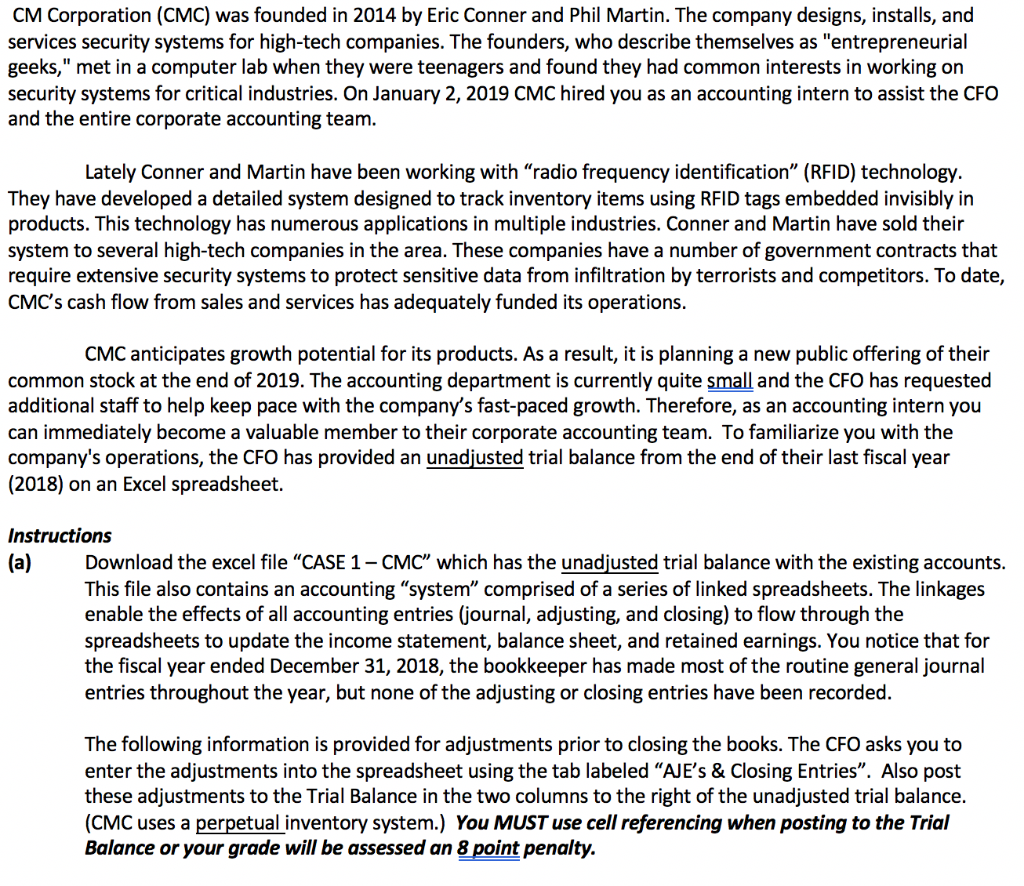
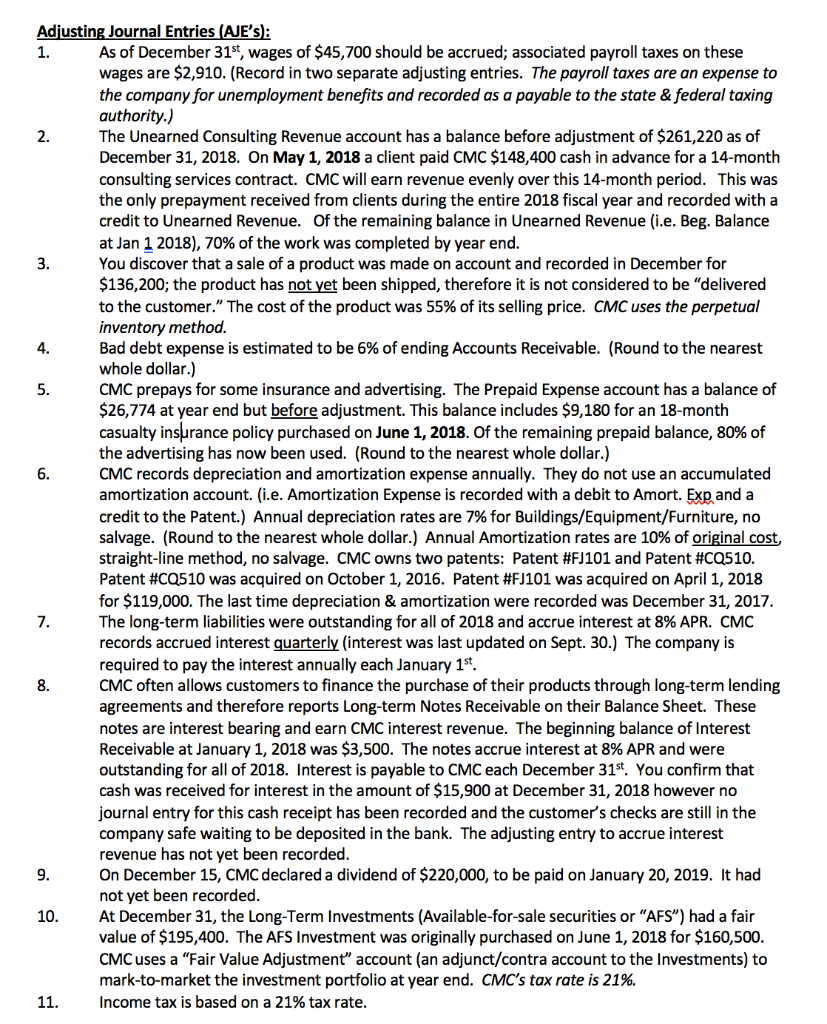

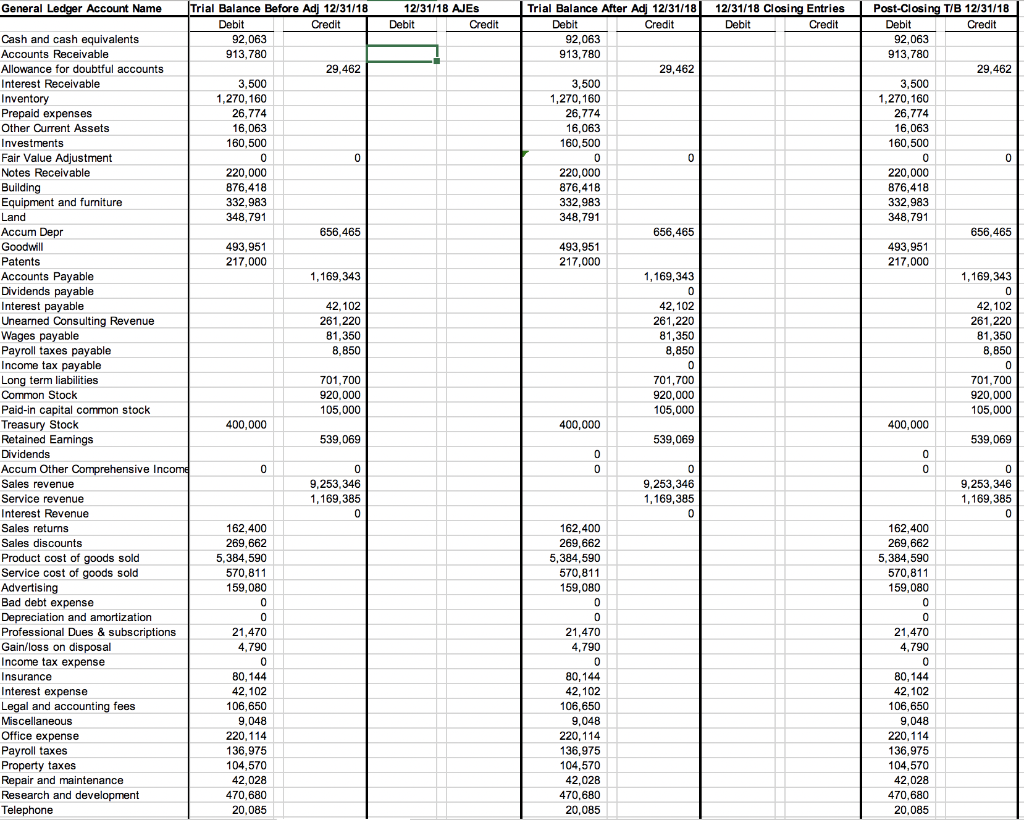

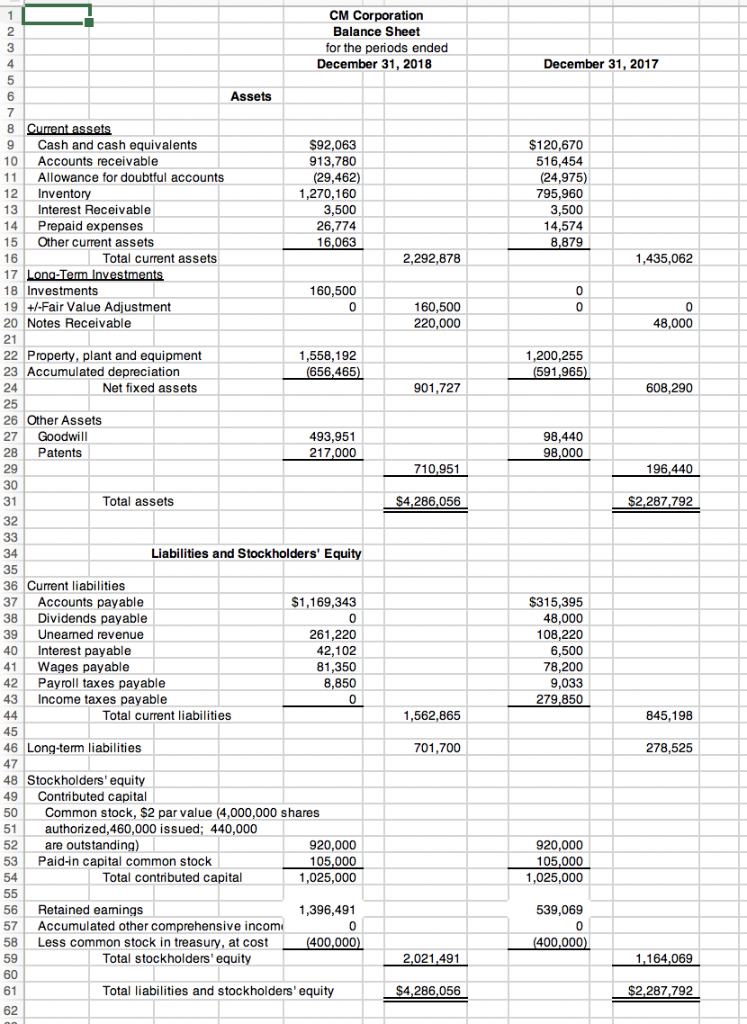
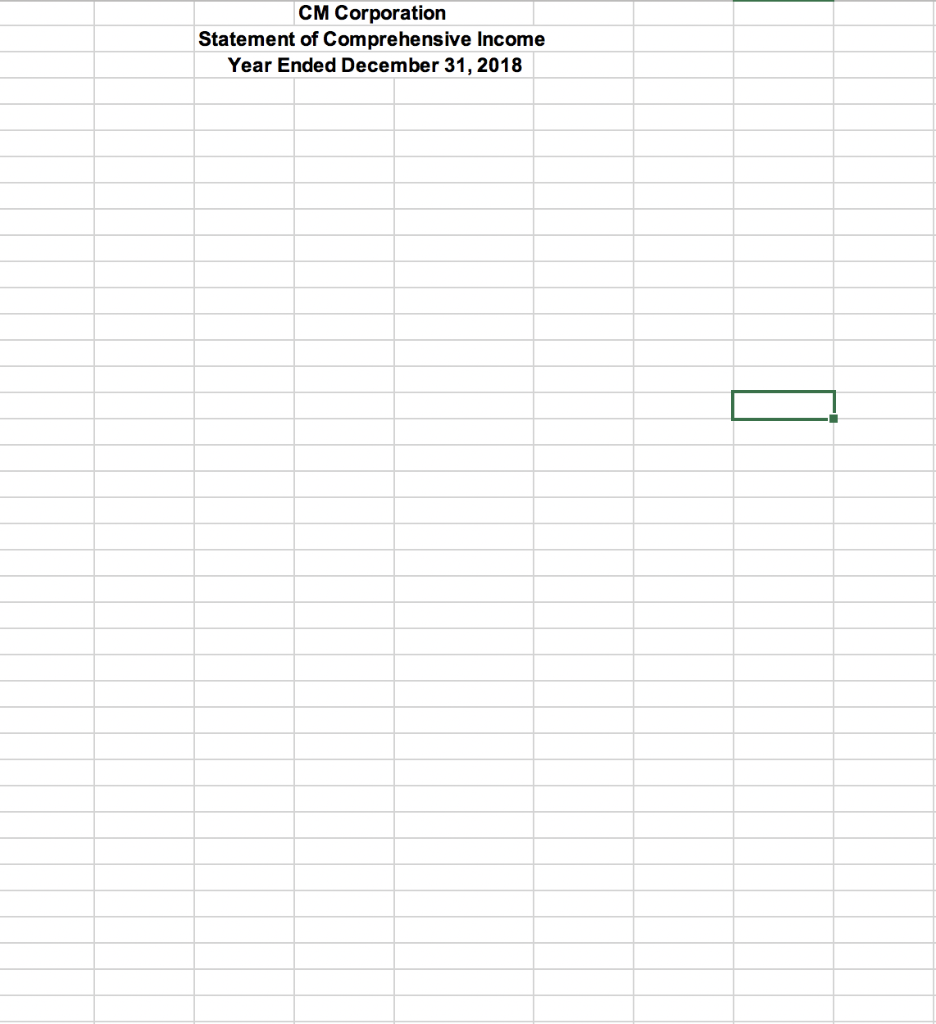

CM Corporation (CMC) was founded in 2014 by Eric Conner and Phil Martin. The company designs, installs, and services security systems for high-tech companies. The founders, who describe themselves as "entrepreneurial geeks," met in a computer lab when they were teenagers and found they had common interests in working on security systems for critical industries. On January 2, 2019 CMC hired you as an accounting intern to assist the CFO and the entire corporate accounting team. Lately Conner and Martin have been working with "radio frequency identification" (RFID) technology. They have developed a detailed system designed to track inventory items using RFID tags embedded invisibly in products. This technology has numerous applications in multiple industries. Conner and Martin have sold their system to several high-tech companies in the area. These companies have a number of government contracts that require extensive security systems to protect sensitive data from infiltration by terrorists and competitors. To date, CMC's cash flow from sales and services has adequately funded its operations. CMC anticipates growth potential for its products. As a result, it is planning a new public offering of their common stock at the end of 2019. The accounting department is currently quite small and the CFO has requested additional staff to help keep pace with the company's fast-paced growth. Therefore, as an accounting intern you can immediately become a valuable member to their corporate accounting team. To familiarize you with the company's operations, the CFO has provided an unadjusted trial balance from the end of their last fiscal year (2018) on an Excel spreadsheet. Instructions (a) Download the excel file "CASE 1- CMC" which has the unadjusted trial balance with the existing accounts. This file also contains an accounting "system" comprised of a series of linked spreadsheets. The linkages enable the effects of all accounting entries (journal, adjusting, and closing) to flow through the spreadsheets to update the income statement, balance sheet, and retained earnings. You notice that for the fiscal year ended December 31, 2018, the bookkeeper has made most of the routine general journal entries throughout the year, but none of the adjusting or closing entries have been recorded. The following information is provided for adjustments prior to closing the books. The CFO asks you to enter the adjustments into the spreadsheet using the tab labeled "AJE's & Closing Entries". Also post these adjustments to the Trial Balance in the two columns to the right of the unadjusted trial balance. (CMC uses a perpetual inventory system.) You MUST use cell referencing when posting to the Trial Balance or your grade will be assessed an 8 point penalty. Adjusting Journal Entries (AJE's): As of December 31st, wages of $45,700 should be accrued; associated payroll taxes on these wages are $2,910. (Record in two separate adjusting entries. The payroll taxes are an expense to the company for unemployment benefits and recorded as a payable to the state & federal taxing authority.) The Unearned Consulting Revenue account has a balance before adjustment of $261,220 as of December 31, 2018. On May 1, 2018 a client paid CMC $148,400 cash in advance for a 14-month consulting services contract. CMC will earn revenue evenly over this 14-month period. This was the only prepayment received from clients during the entire 2018 fiscal year and recorded with a credit to Unearned Revenue. Of the remaining balance in Unearned Revenue (i.e. Beg. Balance 1. 2. at Jan 1 2018), 70% of the work was completed by year end. You discover that a sale of a product was made on account and recorded in December for $136,200; the product has not yet been shipped, therefore it is not considered to be "delivered 3. to the customer." The cost of the product was 55% of its selling price. CMC uses the perpetual inventory method. Bad debt expense is estimated to be 6% of ending Accounts Receivable. (Round to the nearest whole dollar.) CMC prepays for some insurance and advertising. The Prepaid Expense account has a balance of $26,774 at year end but before adjustment. This balance includes $9,180 for an 18-month casualty insurance policy purchased on June 1, 2018. Of the remaining prepaid balance, 80% of the advertising has now been used. (Round to the nearest whole dollar.) CMC records depreciation and amortization expense annually. They do not use an accumulated amortization account. (i.e. Amortization Expense is recorded with a debit to Amort. Exp and a credit to the Patent.) Annual depreciation rates are 7% for Buildings/Equipment/Furniture, no salvage. (Round to the nearest whole dollar.) Annual Amortization rates are 10% of original cost, straight-line method, no salvage. CMC owns two patents: Patent #FJ101 and Patent #CQ510. Patent #CQ510 was acquired on October 1, 2016. Patent #FJ101 was acquired on April 1, 2018 for $119,000. The last time depreciation & amortization were recorded was December 31, 2017. The long-term liabilities were outstanding for all of 2018 and accrue interest at 8% APR. CMC records accrued interest quarterly (interest was last updated on Sept. 30.) The company is required to pay the interest annually each January 1st. CMC often allows customers to finance the purchase of their products through long-term lending agreements and therefore reports Long-term Notes Receivable on their Balance Sheet. These notes are interest bearing and earn CMC interest revenue. The beginning balance of Interest Receivable at January 1, 2018 was $3,500. The notes accrue interest at 8% APR and were outstanding for all of 2018. Interest is payable to CMC each December 31st. You confirm that cash was received for interest in the amount of $15,900 at December 31, 2018 however no 4. 5. 6. 7 8 journal entry for this cash receipt has been recorded and the customer's checks are still in the company safe waiting to be deposited in the bank. The adjusting entry to accrue interest revenue has not yet been recorded. December CMC decl dividend of $220,000, paid on January 20, 2019. had 9. not yet been recorded. At December 31, the Long-Term Investments (Available-for-sale securities or "AFS") had a fair value of $195,400. The AFS Investment was originally purchased on June 1, 2018 for $160,500. 10. CMC uses a "Fair Value Adjustment" account (an adjunct/contra account to the Investments) to mark-to-market the investment portfolio at year end. CMC's tax rate is 21%. 11 Income tax is based on a 21% tax rate. oi (b) After making the 11 adjusting entries in (a), record the appropriate closing entries on the spreadsheet provided using the tab labeled "AJES and Closing Entries". Post to the Trial Balance. (c) Complete the each of the required financial statements (Statement of Comprehensive Income, and Statement of Stockholder's Equity) in good form. The Statement of Stockholder's Equity should reconcile with your balance sheet, income statement, & Statement of Comprehensive Income. (Use cell referencing to link the appropriate cells from the other financial statements. Keep in mind that not all cells on the Statement of Stockholder's Equity will require any updates. For example, no new stock was issued during 2018; the balance in the contributed capital accounts will therefore not change.) Trial Balance Before Adj 12/31/18 Credit Trial Balance After Adj 12/31/18 General Ledger Account Name 12/31/18 AJES 12/31/18 Closing Entries Post-Closing T/B 12/31/18 Credit Debit Debit Credit Debit Debit Credit Debit Credit 92.063 Cash and cash equivalents Accounts Receivable 92,063 92.063 913.780 913,780 913.780 Allowance for doubtful accounts 29,462 29,462 29,462 Interest Receivable Inventory 3,500 1,270,160 3,500 1,270,160 3,500 1,270,160 ses Assets 20 16 063 16.063 16.063 160,500 Investments 160,500 160,500 Fair Value Adjustment Notes Receivable Building Equipment and furniture 0 0 0 0 220,000 876,418 220,000 876,418 220,000 876,418 332.983 332.983 332,983 348.791 348.791 348,791 Land 656,465 656,465 Accum Depr 656.465 Goodwill 493.951 493.951 493,951 217,000 Patents 217.000 217,000 Accounts Payable Dividends payable 1,169,343 1,169,343 1,169,343 Interest payable 42,102 42,102 42,102 sulting Revenue earr Wor pavable 81.350 81.350 81.350 Payroll taxes payable Income tax payable Long term liabilities Common Stock 8,850 8,850 ,850 0 701.700 701,700 920,000 701.700 920,000 920,000 Paid-in capital common stock 105,000 105,000 105,000 Treasury Stock Retained Eamings 400.000 400,000 400,000 539,069 539,069 539,069 Dividends 0 0 Accum Other Comprehensive Income 0 0 C 9,253,346 1,169,385 Sales revenue 9,253,346 9,253,346 Service revenue Interest Revenue 1.169.385 1,169.385 0 0 Sales retuns 162.400 162,400 269,662 162,400 Sales discounts 269.662 269,662 Product cost of goods sold goods sold 5,384,590 5,384,590 5,384,590 159,080 Advertising 159,080 159.080 Bad debt expense 0 0 0 Depreciation and amortization Professional Dues & subscriptions 0 21,470 ,790 21,470 21,470 Gain/loss on disposal 4,790 4,790 0 0 Income tax expense Insurance 80.144 80.144 80,144 Interest expense 42.102 42,102 42,102 Legal and accounting fees Miscellaneous 106,650 106,650 106,650 9,048 9,048 9,048 Office expense Payroll taxes Property 220.114 220.114 220.114 136,975 136,975 136,975 intenance Research and development 42.028 42.028 42.028 470.680 470.680 470,680 20,085 20,085 Telephone 20,085 Research and development 470,680 470,680 470,680 20.085 20.085 20,085 Telephone Travel and entertainment Utilities Expense Wage Expense Salaries Officers Income Summary Unrealized Gain/Loss-AFS 38.391 38.391 38.391 47,049 47,049 47,049 964,670 964,670 964.670 710,000 710,000 710,000 14.937.292 14,937,292 14,937.292 14.937 292 14.937.292 14.937.292 0 0 CM Corporation Balance Sheet for the periods ended December 31, 2018 1 3 December 31, 2017 Assets 7 8 Current assets Cash and cash equivalents $92,063 $120,670 516,454 (24,975) 10 Accounts receivable 913,780 (29,462) 1,270,160 3,500 26,774 Allowance for doubtful accounts 11 12 Inventory Interest Receivable Prepaid expenses 795,960 13 3,500 14 14.574 15 Other current assets 16,063 8,879 Total current assets 1,435,062 16 2,292,878 17 Long-Tem Investments 0 18 Investments 160,500 19 +-Fair Value Adjustment 20 Notes Receivable 160,500 0 0 220,000 48,000 21 22 Property, plant and equipment 23 Accumulated depreciation Net fixed assets 1,558,192 1,200,255 (591,965) (656,465) 24 901,727 608,290 25 26 Other Assets Goodwill 27 493,951 217,000 98,440 98,000 28 Patents 710,95 29 196,440 30 $4,286,056 $2,287,792 31 Total assets 32 33 Liabilities and Stockholders' Equity 34 35 36 Current liabilities 37 Accounts payable Dividends payable Uneaned revenue $1,169,343 $315,395 48,000 108,220 6,500 38 39 261,220 Interest payable Wages payable 40 42,102 78,200 41 81,350 42 Payroll taxes payable Income taxes payable 8,850 9,033 43 279,850 Total current liabilities 845,198 44 1,562,865 45 701,700 46 Long-term liabilities 278,525 47 48 Stockholders' equity Contributed Com capital 49 Common stock, $2 par value (4,000,000 shares authorized,460,000 issued; 440,000 are outstanding) Paid-in capital common stock 50 920,000 105,000 1,025,000 920,000 54 105,000 1,025,000 53 Total contributed capital 54 55 Retained eamings Accumulated other comprehensive incom Less common stock in treasury, at cost 1,396,491 56 539,069 57 0 58 (400,000) (400,000) Total stockholders' equity 59 1.164.069 2,021,491 60 Total liabilities and stockholders' equity $4,286,056 $2,287,792 61 62 CM Corporation Statement of Comprehensive Income Year Ended December 31, 2018 CM Corporation oJOdJ Statement of Stockholder's Equity f December 31, 2018 as Accumulated Additional Total Common Treasury Stock Retained Other Comprehensive Stockholder's Equity Paid-In Capital Stock Earnings Income Beg. Balance, 1/1/18 Common Stock Issued Common Stock Repurchased Net Income (18) Other Comprehensive Income (18) Common Stock Dividend (18) End. Balance, 12/31/18 CM Corporation (CMC) was founded in 2014 by Eric Conner and Phil Martin. The company designs, installs, and services security systems for high-tech companies. The founders, who describe themselves as "entrepreneurial geeks," met in a computer lab when they were teenagers and found they had common interests in working on security systems for critical industries. On January 2, 2019 CMC hired you as an accounting intern to assist the CFO and the entire corporate accounting team. Lately Conner and Martin have been working with "radio frequency identification" (RFID) technology. They have developed a detailed system designed to track inventory items using RFID tags embedded invisibly in products. This technology has numerous applications in multiple industries. Conner and Martin have sold their system to several high-tech companies in the area. These companies have a number of government contracts that require extensive security systems to protect sensitive data from infiltration by terrorists and competitors. To date, CMC's cash flow from sales and services has adequately funded its operations. CMC anticipates growth potential for its products. As a result, it is planning a new public offering of their common stock at the end of 2019. The accounting department is currently quite small and the CFO has requested additional staff to help keep pace with the company's fast-paced growth. Therefore, as an accounting intern you can immediately become a valuable member to their corporate accounting team. To familiarize you with the company's operations, the CFO has provided an unadjusted trial balance from the end of their last fiscal year (2018) on an Excel spreadsheet. Instructions (a) Download the excel file "CASE 1- CMC" which has the unadjusted trial balance with the existing accounts. This file also contains an accounting "system" comprised of a series of linked spreadsheets. The linkages enable the effects of all accounting entries (journal, adjusting, and closing) to flow through the spreadsheets to update the income statement, balance sheet, and retained earnings. You notice that for the fiscal year ended December 31, 2018, the bookkeeper has made most of the routine general journal entries throughout the year, but none of the adjusting or closing entries have been recorded. The following information is provided for adjustments prior to closing the books. The CFO asks you to enter the adjustments into the spreadsheet using the tab labeled "AJE's & Closing Entries". Also post these adjustments to the Trial Balance in the two columns to the right of the unadjusted trial balance. (CMC uses a perpetual inventory system.) You MUST use cell referencing when posting to the Trial Balance or your grade will be assessed an 8 point penalty. Adjusting Journal Entries (AJE's): As of December 31st, wages of $45,700 should be accrued; associated payroll taxes on these wages are $2,910. (Record in two separate adjusting entries. The payroll taxes are an expense to the company for unemployment benefits and recorded as a payable to the state & federal taxing authority.) The Unearned Consulting Revenue account has a balance before adjustment of $261,220 as of December 31, 2018. On May 1, 2018 a client paid CMC $148,400 cash in advance for a 14-month consulting services contract. CMC will earn revenue evenly over this 14-month period. This was the only prepayment received from clients during the entire 2018 fiscal year and recorded with a credit to Unearned Revenue. Of the remaining balance in Unearned Revenue (i.e. Beg. Balance 1. 2. at Jan 1 2018), 70% of the work was completed by year end. You discover that a sale of a product was made on account and recorded in December for $136,200; the product has not yet been shipped, therefore it is not considered to be "delivered 3. to the customer." The cost of the product was 55% of its selling price. CMC uses the perpetual inventory method. Bad debt expense is estimated to be 6% of ending Accounts Receivable. (Round to the nearest whole dollar.) CMC prepays for some insurance and advertising. The Prepaid Expense account has a balance of $26,774 at year end but before adjustment. This balance includes $9,180 for an 18-month casualty insurance policy purchased on June 1, 2018. Of the remaining prepaid balance, 80% of the advertising has now been used. (Round to the nearest whole dollar.) CMC records depreciation and amortization expense annually. They do not use an accumulated amortization account. (i.e. Amortization Expense is recorded with a debit to Amort. Exp and a credit to the Patent.) Annual depreciation rates are 7% for Buildings/Equipment/Furniture, no salvage. (Round to the nearest whole dollar.) Annual Amortization rates are 10% of original cost, straight-line method, no salvage. CMC owns two patents: Patent #FJ101 and Patent #CQ510. Patent #CQ510 was acquired on October 1, 2016. Patent #FJ101 was acquired on April 1, 2018 for $119,000. The last time depreciation & amortization were recorded was December 31, 2017. The long-term liabilities were outstanding for all of 2018 and accrue interest at 8% APR. CMC records accrued interest quarterly (interest was last updated on Sept. 30.) The company is required to pay the interest annually each January 1st. CMC often allows customers to finance the purchase of their products through long-term lending agreements and therefore reports Long-term Notes Receivable on their Balance Sheet. These notes are interest bearing and earn CMC interest revenue. The beginning balance of Interest Receivable at January 1, 2018 was $3,500. The notes accrue interest at 8% APR and were outstanding for all of 2018. Interest is payable to CMC each December 31st. You confirm that cash was received for interest in the amount of $15,900 at December 31, 2018 however no 4. 5. 6. 7 8 journal entry for this cash receipt has been recorded and the customer's checks are still in the company safe waiting to be deposited in the bank. The adjusting entry to accrue interest revenue has not yet been recorded. December CMC decl dividend of $220,000, paid on January 20, 2019. had 9. not yet been recorded. At December 31, the Long-Term Investments (Available-for-sale securities or "AFS") had a fair value of $195,400. The AFS Investment was originally purchased on June 1, 2018 for $160,500. 10. CMC uses a "Fair Value Adjustment" account (an adjunct/contra account to the Investments) to mark-to-market the investment portfolio at year end. CMC's tax rate is 21%. 11 Income tax is based on a 21% tax rate. oi (b) After making the 11 adjusting entries in (a), record the appropriate closing entries on the spreadsheet provided using the tab labeled "AJES and Closing Entries". Post to the Trial Balance. (c) Complete the each of the required financial statements (Statement of Comprehensive Income, and Statement of Stockholder's Equity) in good form. The Statement of Stockholder's Equity should reconcile with your balance sheet, income statement, & Statement of Comprehensive Income. (Use cell referencing to link the appropriate cells from the other financial statements. Keep in mind that not all cells on the Statement of Stockholder's Equity will require any updates. For example, no new stock was issued during 2018; the balance in the contributed capital accounts will therefore not change.) Trial Balance Before Adj 12/31/18 Credit Trial Balance After Adj 12/31/18 General Ledger Account Name 12/31/18 AJES 12/31/18 Closing Entries Post-Closing T/B 12/31/18 Credit Debit Debit Credit Debit Debit Credit Debit Credit 92.063 Cash and cash equivalents Accounts Receivable 92,063 92.063 913.780 913,780 913.780 Allowance for doubtful accounts 29,462 29,462 29,462 Interest Receivable Inventory 3,500 1,270,160 3,500 1,270,160 3,500 1,270,160 ses Assets 20 16 063 16.063 16.063 160,500 Investments 160,500 160,500 Fair Value Adjustment Notes Receivable Building Equipment and furniture 0 0 0 0 220,000 876,418 220,000 876,418 220,000 876,418 332.983 332.983 332,983 348.791 348.791 348,791 Land 656,465 656,465 Accum Depr 656.465 Goodwill 493.951 493.951 493,951 217,000 Patents 217.000 217,000 Accounts Payable Dividends payable 1,169,343 1,169,343 1,169,343 Interest payable 42,102 42,102 42,102 sulting Revenue earr Wor pavable 81.350 81.350 81.350 Payroll taxes payable Income tax payable Long term liabilities Common Stock 8,850 8,850 ,850 0 701.700 701,700 920,000 701.700 920,000 920,000 Paid-in capital common stock 105,000 105,000 105,000 Treasury Stock Retained Eamings 400.000 400,000 400,000 539,069 539,069 539,069 Dividends 0 0 Accum Other Comprehensive Income 0 0 C 9,253,346 1,169,385 Sales revenue 9,253,346 9,253,346 Service revenue Interest Revenue 1.169.385 1,169.385 0 0 Sales retuns 162.400 162,400 269,662 162,400 Sales discounts 269.662 269,662 Product cost of goods sold goods sold 5,384,590 5,384,590 5,384,590 159,080 Advertising 159,080 159.080 Bad debt expense 0 0 0 Depreciation and amortization Professional Dues & subscriptions 0 21,470 ,790 21,470 21,470 Gain/loss on disposal 4,790 4,790 0 0 Income tax expense Insurance 80.144 80.144 80,144 Interest expense 42.102 42,102 42,102 Legal and accounting fees Miscellaneous 106,650 106,650 106,650 9,048 9,048 9,048 Office expense Payroll taxes Property 220.114 220.114 220.114 136,975 136,975 136,975 intenance Research and development 42.028 42.028 42.028 470.680 470.680 470,680 20,085 20,085 Telephone 20,085 Research and development 470,680 470,680 470,680 20.085 20.085 20,085 Telephone Travel and entertainment Utilities Expense Wage Expense Salaries Officers Income Summary Unrealized Gain/Loss-AFS 38.391 38.391 38.391 47,049 47,049 47,049 964,670 964,670 964.670 710,000 710,000 710,000 14.937.292 14,937,292 14,937.292 14.937 292 14.937.292 14.937.292 0 0 CM Corporation Balance Sheet for the periods ended December 31, 2018 1 3 December 31, 2017 Assets 7 8 Current assets Cash and cash equivalents $92,063 $120,670 516,454 (24,975) 10 Accounts receivable 913,780 (29,462) 1,270,160 3,500 26,774 Allowance for doubtful accounts 11 12 Inventory Interest Receivable Prepaid expenses 795,960 13 3,500 14 14.574 15 Other current assets 16,063 8,879 Total current assets 1,435,062 16 2,292,878 17 Long-Tem Investments 0 18 Investments 160,500 19 +-Fair Value Adjustment 20 Notes Receivable 160,500 0 0 220,000 48,000 21 22 Property, plant and equipment 23 Accumulated depreciation Net fixed assets 1,558,192 1,200,255 (591,965) (656,465) 24 901,727 608,290 25 26 Other Assets Goodwill 27 493,951 217,000 98,440 98,000 28 Patents 710,95 29 196,440 30 $4,286,056 $2,287,792 31 Total assets 32 33 Liabilities and Stockholders' Equity 34 35 36 Current liabilities 37 Accounts payable Dividends payable Uneaned revenue $1,169,343 $315,395 48,000 108,220 6,500 38 39 261,220 Interest payable Wages payable 40 42,102 78,200 41 81,350 42 Payroll taxes payable Income taxes payable 8,850 9,033 43 279,850 Total current liabilities 845,198 44 1,562,865 45 701,700 46 Long-term liabilities 278,525 47 48 Stockholders' equity Contributed Com capital 49 Common stock, $2 par value (4,000,000 shares authorized,460,000 issued; 440,000 are outstanding) Paid-in capital common stock 50 920,000 105,000 1,025,000 920,000 54 105,000 1,025,000 53 Total contributed capital 54 55 Retained eamings Accumulated other comprehensive incom Less common stock in treasury, at cost 1,396,491 56 539,069 57 0 58 (400,000) (400,000) Total stockholders' equity 59 1.164.069 2,021,491 60 Total liabilities and stockholders' equity $4,286,056 $2,287,792 61 62 CM Corporation Statement of Comprehensive Income Year Ended December 31, 2018 CM Corporation oJOdJ Statement of Stockholder's Equity f December 31, 2018 as Accumulated Additional Total Common Treasury Stock Retained Other Comprehensive Stockholder's Equity Paid-In Capital Stock Earnings Income Beg. Balance, 1/1/18 Common Stock Issued Common Stock Repurchased Net Income (18) Other Comprehensive Income (18) Common Stock Dividend (18) End. Balance, 12/31/18














